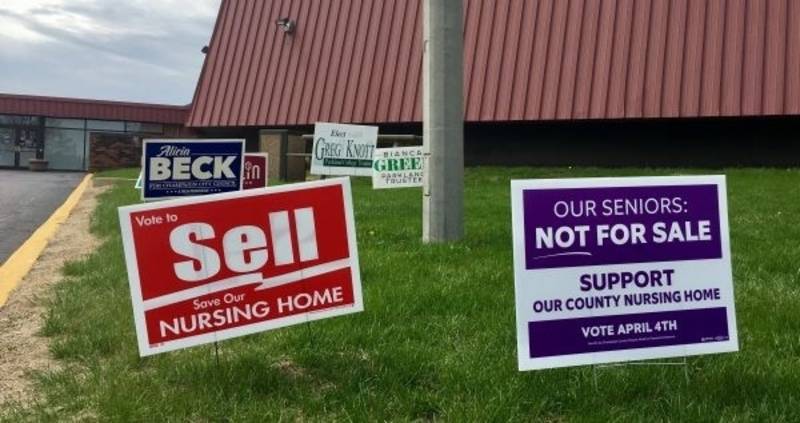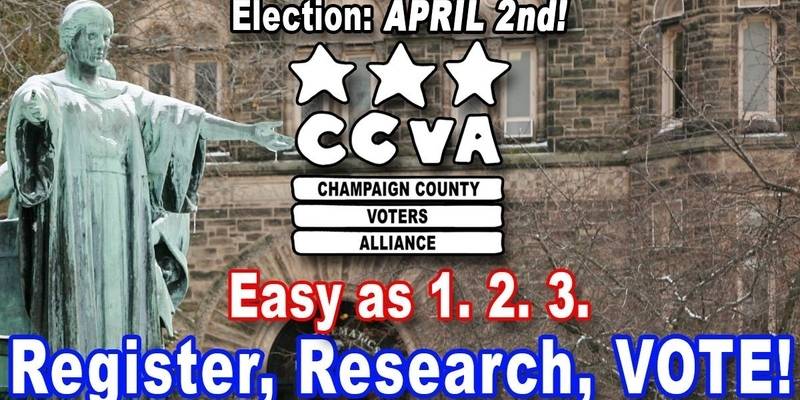This fall, campus was buzzing with constant Get Out the Vote efforts from local candidates and groups hoping to amplify their voices. President Obama’s visit to UIUC was a prime opportunity for voter registration, even in the rain, and that was when I first encountered Champaign County Voters Alliance.
Juggling my umbrella and clipboard, I was given a stack of yellow business cards encouraging people to visit votechampaign.org. When students avoided eye contact and said they were already registered, a yellow business card went with them, with what I hoped was good enough information about the candidates and polling places. When I checked the website later, it turned out to be a better resource than I had expected.
James Manrique started Champaign County Voters Alliance in 2017 after the municipal election that included the nursing home referendum. Manrique said the election saw around 20% voter turnout, “which was unfortunately high for a municipal election. It’s such an important thing. [The Champaign County Nursing Home] is like a 100-year-old institution and to have it decided by 2,000 votes when there were 100,000 registered people that didn’t vote, clearly voter registration wasn’t the core problem of voter turnout.”

“I didn’t know about that election until a couple of weeks before it happened. There were yard signs with good messages, but it wasn’t clear that the election was happening on a given day. When we tried to find candidate information it was really hard to find and scattered across multiple places. Some of it was posted the week before the election happened so there wasn’t time to read and absorb it. So that’s what started this whole project and initiative.”
The goal of the non-partisan alliance is to increase voter turnout in Champaign County as much as possible. “I’ve seen so many elections where the margins are 5%, and yet, for presidential elections there’s only 60% voter turnout,” said Manrique. “If even a small number more turned out, they could change the outcome of the election. Easily. People say, ‘My vote doesn’t matter.’ You don’t understand! It matters so much!”
Manrique wrote an op-ed in Smile Politely calling for increased awareness of municipal and primary elections, including lamppost signs in downtown Champaign letting voters know the date. He said the city seemed accommodating to that idea. “We try to use flyers in community places and businesses so we can get that voter date out for municipal elections and primaries.” The university has also linked to the website to help students get clear information on local elections.
The biggest resource Champaign County Voter Alliance has provided is their Candidate Information Guide. Manrique has created and maintained a website with partners Linda Bair and Ann Prisland that publishes a questionnaire of all candidates along with their contact information. Champaign County’s 2019 Municipal Election Candidate Information went live on Monday morning.
The website posts the information for each candidate, not pulling quotes from across other media, but CCVA’s own questions. “We ask, ‘What is the importance of the position you’re running for?’, ‘Why are you qualified for that position?’, and ‘If elected, what is something you’d like to do in this position, and how long will it take you to do that?’”
“We try to keep the questions open-ended. Especially for down-ballot races, it’s hard to know exactly what a park commissioner does, what it means to elect a circuit judge,” said Manrique. The down-ballot races can have a large influence on policy in the area, and learning about the candidates’ views beyond differentiating themselves from an opponent is an important part of an informed vote.
“We’re in a situation in Champaign-Urbana where all these national issues are reflected in our community,” said Manrique. “Champaign County is a mix of urban and rural, college students and elderly. There are so many things nationally mirrored in our community locally. The refugee population, the immigrant community, child separations, and working with ICE, which happens in our community and was on the ballot in 2018. The candidates for sheriff were split on working with ICE. You had a choice in that matter on something that’s typically a national issue, but you could choose it locally here and have an effect on it.”
The 2018 election had a massive swing in turnout compared to 2017’s municipal elections. Campus precincts outperformed wealthy Champaign precincts thanks to massive GOTV efforts by organizations and programs like Adopt-a-Precinct through The People’s Agenda.
Of course comparing midterm elections to municipal elections is apples and oranges, but Manrique says votes for restorative justice on the school board is as impactful as voting for public defenders as circuit judges. “Get out and vote. The more voters focus on lower ballot issues, the bigger the impact they can have.”
Tuesday, April 2nd voters across Champaign County will have the opportunity to vote for Parkland College Board of Trustees, school board members, mayor, park commissioners, village trustees, and more. Every candidate in Champaign, Urbana, Mahomet, and Rantoul has been asked to fill out the questionnaire for CCVA’s guide, and all of the responses are updated as they are received.
Champaign County Voters Alliance is growing with each election, and is starting to connect with League of Women Voters. “The great thing that our local League does here is the Candidate Forums,” said Manrique. Those forums are a natural link to the candidate information the alliance provides. And he hopes more collaboration between voter turnout groups will create a stronger, more engaged electorate in Champaign County.








